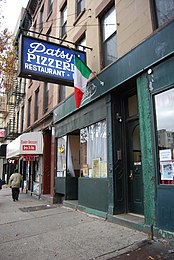
East Harlem’s Historic Church Set for Demolition

### East Harlem’s Holy Rosary Church Faces Possible Demolition Amid Controversial Real Estate Sale
An East Harlem Roman Catholic church, Holy Rosary Church, which once stood as a symbol of faith and architectural beauty, now faces the threat of complete demolition. A permit filed with the New York City Department of Buildings in October signals the potential end for the church, marking another chapter in the evolving story of urban development and shifting community priorities.
#### The Historical Legacy of Holy Rosary Church
Holy Rosary Church was constructed in 1894 in the Romanesque Revival style, marked by its imposing architecture and religious significance. For many years, it served as a spiritual haven for generations of East Harlem residents. However, like many other religious institutions in recent years, it has fallen victim to dwindling congregation numbers and financial difficulties.
In 2015, the Roman Catholic Archdiocese of New York shut down Holy Rosary Church as part of a broad restructuring. Citing declining church attendance and increasing financial strain, the Archdiocese merged Holy Rosary with nearby St. Paul Church on 117th Street to form a joint parish: St. Paul and Holy Rosary Roman Catholic Church. This consolidation was part of a larger effort by the Archdiocese to reduce the number of New York City parishes from 112 to 55.
#### A Controversial Real Estate Deal
In August 2023, the Archdiocese finalized the sale of the deconsecrated Holy Rosary Church site to Golani Development LLC for $5 million. The deal, subject to state court oversight due to its religious designation, has drawn attention as East Harlem undergoes significant gentrification and real estate development.
Golani Development, owned by Sharon Kahen, has big plans for the neighborhood. In a 2013 interview with *The New York Times*, Kahen declared his intention to invest $75 million to integrate East Harlem with the Upper East Side. This acquisition adds fuel to that mission. However, the community is left wondering what will become of one of its historical landmarks, especially now that the developer has filed a petition to demolish the cherished church.
#### The Cost of Demolition and Future Plans
According to the demolition petition filed by Golani and its engineering partners, it would cost approximately $450,000 to tear down the Holy Rosary Church building. The site, which is zoned for residential development, offers clues as to what might come in its place — most likely new housing units.
Despite its deteriorated condition, with peeling walls, a broken staircase, and dusty pews as shown in recent court filings, the church holds sentimental value to many of East Harlem’s long-standing residents. A campaign was launched in 2014 in an attempt to restore and preserve the church, emphasizing its importance to the community’s cultural and spiritual fabric. However, these efforts were ultimately in vain as forces outside the community, particularly the real estate market, seemed to dictate its fate.
#### Community Reactions: A Fight to Preserve Memory
The impending demolition of Holy Rosary Church has prompted a growing conversation about the cultural cost of urban redevelopment. While the Archdiocese emphasizes the consolidation of services and the presence of a “functioning parish” at the nearby St. Paul Church, community members are mourning the potential loss of yet another historical site. Some have taken to social media platforms, such as the Facebook group “Restoration Campaign of Holy Rosary Church of East Harlem,” to express their grief and rally support for preserving local history.
“In a city where landmarks are vanishing rapidly, how can anyone consider closing down such a beautiful pilgrim church?” asks a post from the Restoration Campaign group, echoing the sentiments of many who feel the pressures of gentrification in East Harlem.
For some, the sale of Holy Rosary Church represents more than just the loss of a religious institution—it reflects the changing identity of East Harlem, a neighborhood long known for its rich cultural history but now increasingly shaped by real estate development and commercial interests.
#### Conclusion: A Neighborhood at a Crossroads
The sale and potential demolition of Holy Rosary Church in East Harlem highlight a larger trend across urban areas worldwide, where long-standing community landmarks are increasingly at risk of being replaced by new construction to accommodate gentrification and population growth.
While progress and modernization are inevitable, balancing the needs of a community with development is vital. Holy Rosary Church serves as a reminder of the delicate and ongoing struggle to maintain a community’s cultural identity in the face of rapid urban changes. As East Harlem evolves, the question remains: What can be done to honor and preserve the neighborhood’s historical roots while embracing its future?
**Support for Independent Journalism**
*Hyperallergic* strives to provide insightful, independent journalism on topics significant to the art and culture sectors, including issues facing local communities like East Harlem. If you value our coverage, please consider becoming a supporting member. Your contribution helps keep articles like